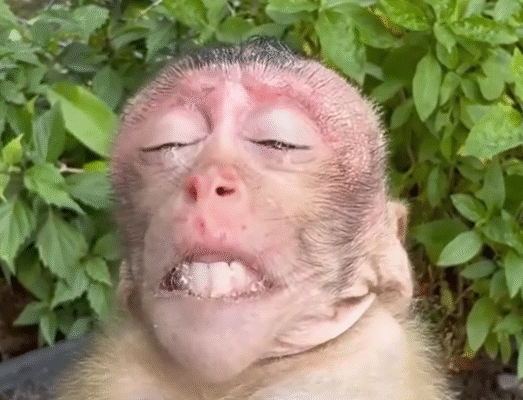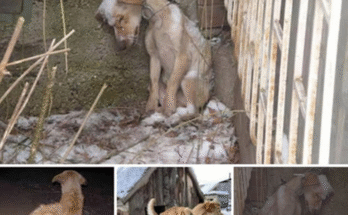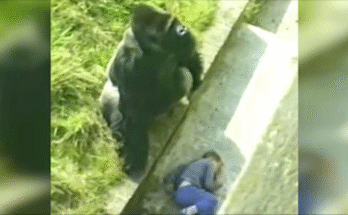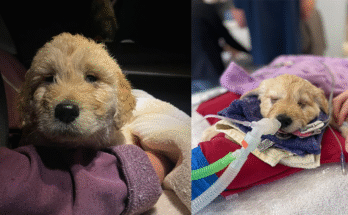In the heart of a dense tropical forest, where the sun filters through layers of emerald leaves and birds sing above the canopy, a tiny baby monkey cried out for help. Lost, frightened, and alone, the infant clung to a low-hanging branch, trembling with exhaustion. His mother was nowhere in sight, and danger lurked around every corner. But this was not the end of his story. In fact, it was just the beginning—a tale of compassion, bravery, and the determination to rescue a baby monkey who had every reason to give up.

The Discovery
It all started on a quiet morning when a group of forest rangers from the local wildlife rescue team were doing their routine patrol near the forest’s edge. They had received reports of unusual animal sounds coming from a nearby area where logging had recently been prohibited. As they moved cautiously through the undergrowth, one of the rangers, named Dara, paused. He heard a high-pitched, sorrowful sound.
It didn’t take long before the team found the source: a tiny monkey—barely a few weeks old—clinging desperately to a fallen tree. His fur was matted, his eyes wide with fear, and his limbs weak from dehydration. There were no signs of other monkeys around. The team looked at each other in silence, understanding the gravity of the situation. This baby couldn’t survive much longer on his own.

First Steps to Safety
Gently, Dara approached the baby monkey, speaking softly to avoid frightening him. Using his scarf, he created a small sling and carefully lifted the baby into it. The monkey whimpered but didn’t resist—he was too tired. The team immediately radioed back to the rescue center and began the trek back, knowing they had to move fast.
Back at the rescue center, the baby monkey was placed in a warm, quiet enclosure. He was given water through a dropper, and a veterinary team began their assessment. They found minor injuries, a slight fever, and signs of severe stress. They named him Milo, after the river that flowed near where he was found.
Healing Begins
Over the next few days, Milo’s condition improved slowly. The caretakers fed him formula, mimicking the nutrition he would’ve received from his mother. They gave him soft blankets, warm lights, and even a stuffed animal shaped like a monkey to give him comfort.
But the emotional wounds were just as deep as the physical ones. He often cried at night and didn’t respond to other animals nearby. It became clear that Milo needed more than food and shelter—he needed love, patience, and time.
That’s when Thida, one of the animal behavior specialists, stepped in. She began spending hours each day beside Milo’s enclosure, reading to him, talking to him, and offering gentle touches through the bars. Eventually, Milo started to respond. He climbed onto her hand, clung to her fingers, and nestled into her palm for naps. A bond was forming.
Learning to Live Again
As Milo grew stronger, the team introduced new activities to help him develop. He was given climbing ropes, swinging branches, and soft chew toys. These tools were essential in helping him develop the skills he would need if he ever returned to the wild.
Milo also began interacting with other rescued monkeys. At first, he was shy, hiding behind Thida whenever others came close. But curiosity took over, and he started playing with a young female monkey named Lulu. They became fast friends, grooming each other and sharing food.
The caretakers were thrilled—Milo was not only physically healing but emotionally too. The team documented his progress daily, sharing updates with local schools and social media to raise awareness about wildlife rescue efforts. Milo became somewhat of a local celebrity, his story inspiring people to care more about the creatures we share the planet with.
The Bigger Picture
Milo’s story is not unique. Across the world, thousands of baby animals are separated from their parents due to deforestation, poaching, and habitat destruction. The logging site near Milo’s rescue location had been active just months before, and it’s suspected that noise and human interference had caused his troop to flee, leaving him behind.
The rescue center used Milo’s story as a turning point. They worked with local communities and governments to educate people about the importance of preserving forests and protecting animal habitats. Signs were placed around the forest reserve, warning against illegal hunting and highlighting the importance of conservation.
Workshops were held in villages, where children learned about monkeys, birds, and other local wildlife. Milo even became the mascot of the campaign, with posters showing his adorable face and the words “Protect the Future. Rescue the Wild.”



